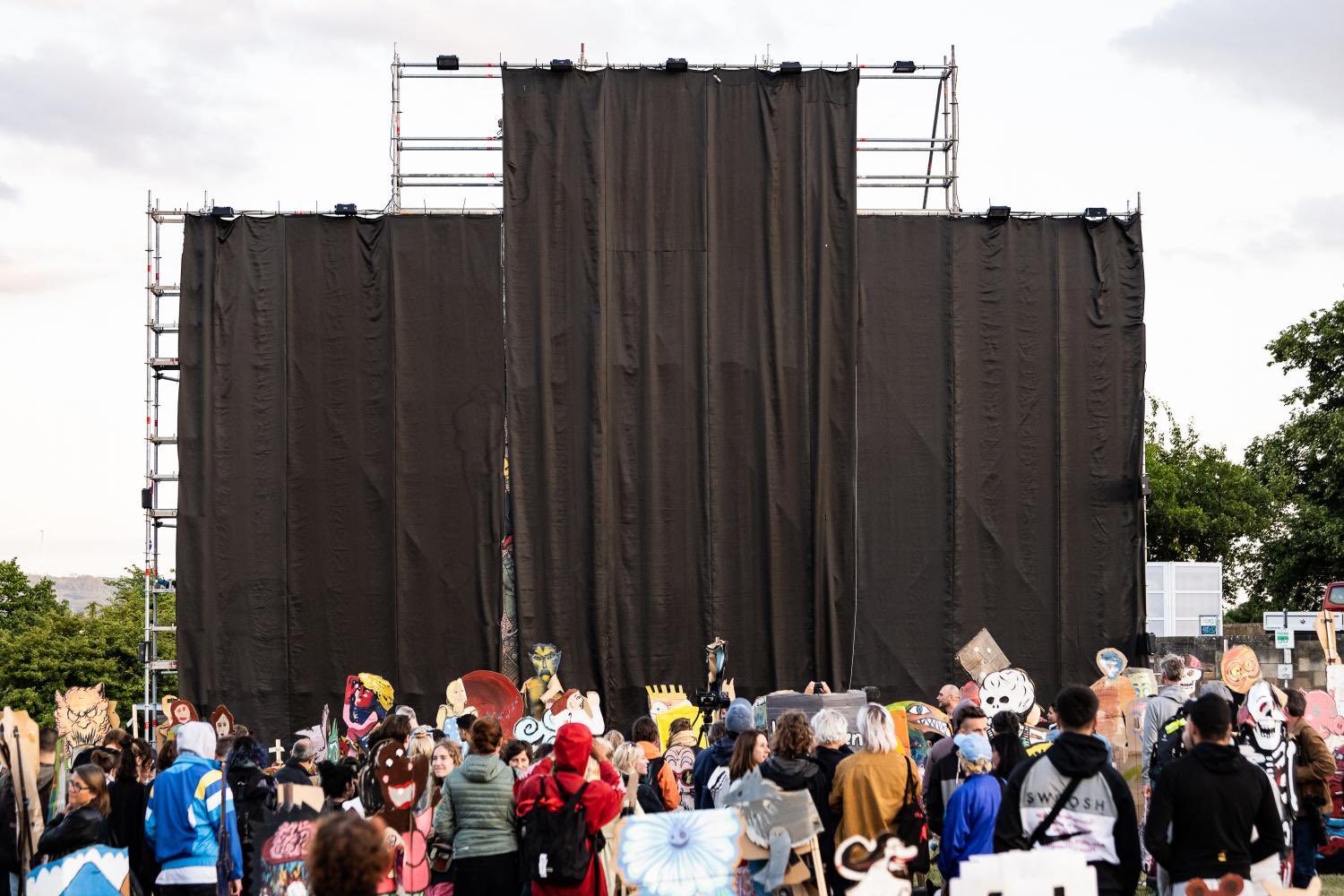News
Documenta Covers Massive Mural Over Antisemitism Concerns


A giant mural by the Indonesian collective Taring Padi suspended from scaffolding on Friedrichsplatz, at the heart of documenta fifteen, is now draped in black fabric. Documenta organizers and the artistic directors ruangrupa announced on June 20 that they had concealed the massive painting because it “triggers antisemitic readings” and installed an accompanying explanation at the outdoor venue.
In a statement, Taring Padi denied the multipart painting, titled People’s Justice (2002), was antisemitic and said it was part of “a campaign against the militarism and violence we experienced during the military dictatorship of [Indonesian military ruler] Suharto.” They defended their work, saying their “visual vocabularies” were “culturally specific to our own experiences.” The artist collective apologized “for the hurt caused in this context,” but said it conceded to covering up the work with “great regret.”
Visitors to documenta fifteen during its opening weekend noticed that in a portion of the large mural, marching soldiers wear helmets bearing names referencing foreign intelligence agencies, including the initials KGB, MI-5, 007, and Mossad, Israel’s intelligence agency. The figure with Mossad written on its helmet has a Star of David on his shirt—and also has the nose of a pig. A second nearby figure is a man with fangs, bloodshot eyes, and sidelocks of hair often associated with Orthodox Jews, and wears a hat with the notorious symbol of the SS, the paramilitary political soldiers of the Nazi Party.
Meron Mendel, director of the Anne Frank Educational Center in Frankfurt, who, writing on Twitter, called for Documenta to remove the artwork over its “clear antisemitic motifs,” summarized the offensive tropes to the Berliner Zeitung: “This is clearly the portrayal of an Orthodox Jew. Giving it the SS symbol and painting a pig-like figure with a Star of David suggests that the artists have a deeply antisemitic view of the world. The Jew as a Nazi and as a pig: these are both antisemitic classics.”
The Israeli embassy in Germany released a statement calling the work “Goebbels-style propaganda,” in reference to the Nazi Party's chief propagandist and rabid antisemite, and said that “not only have all the red lines been crossed, they have been smashed.” The president of the Central Council of Jews in Germany, Josef Schuster repeated that a “red line” had been crossed and that “artistic freedom ends where xenophobia begins.” German politicians from the Green Party backed these criticisms. Claudia Roth, the German minister of culture from the Greens, said she also found these depictions to be examples of antisemitic imagery, that this was where “artistic freedom finds its limits,” and that the curators must “draw the necessary consequences.” Another Green politician, the president of the German-Israel Society, Volker Beck, told Bild daily that he was filing a case with prosecutors in Kassel and Berlin over the imagery.
Documenta’s director general Sabine Schormann said she regretted that “feelings were hurt” but said that the organization’s management does not inspect artworks in advance of their display. She noted that the work was not conceived for documenta fifteen but that it was the first time it had been shown in Europe. However, the deputy chair of the Documenta supervisory board, the Hesse region’s art minister Angela Dorn-Rancke said, “My personal impression is that there is antisemitic imagery here.” At documenta fifteen's opening on Saturday, German president Frank-Walter Steinmeier had reiterated that recognition of the state of Israel was a precondition for any debate in Germany and there were limits on what artists can do when addressing political issues.
Mendel, responding to the June 20 statement from Documenta, criticized the organization for appearing to support “a collective unwilling to confront their own antisemitic images” and for justifying their usage of these antisemitic tropes relative to the context of Indonesia, which has a troubled history of accepting pro-Nazi imagery without understanding the history and violence with which it is associated. Mendel further questioned whether Taring Padi should be allowed to continue displaying their other works in documenta fifteen.
The giant mural People’s Justice was originally created and exhibited at the South Australia Art Festival in Adelaide in 2002. Taring Padi explained that “all figures depicted in the banner reference commonly-known symbols within the Indonesian political context, for example corrupt bureaucracy, military generals and their soldiers which are symbolized by pigs, dogs, and rats to criticize an exploitative capitalist system and military violence.” They noted it had also previously been displayed in 2004 in Jakarta, a 2018 retrospective exhibition in Yogyakarta, and the Polyphonic Southeast Asia Art exhibition in Nanjing in 2019.
Following months of tension stirred up by the right-wing media around ruangrupa’s and participants’ assumed sympathies to criticism of Israel and even proximity to the Palestinian-led Boycott, Divestment, and Sanctions (BDS) movement, which the German government deemed antisemitic in 2019, and after a series of dialogues that were planned to address the contentious issues were canceled in May, Taring Padi lamented that the covered mural had “[become] a monument of mourning for the impossibility of dialogue at this moment. This monument, we hope, will be the starting point for a new dialogue.” On May 4, documenta fifteen had suspended the series of three weekly talks examining topics of antisemitism and racism, announcing instead it would “open the exhibition and first let it speak for itself, as a basis for continuing the discussion in a productive manner.”
HG Masters is ArtAsiaPacific’s deputy editor and deputy publisher.







